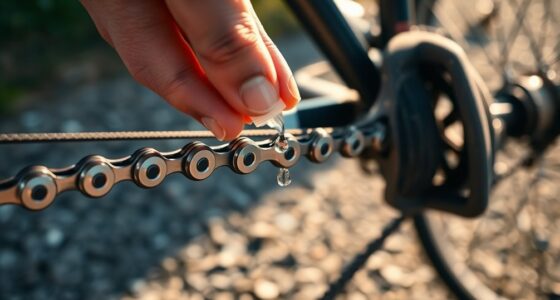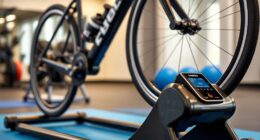Before your ride, check your bike's tires for wear and proper pressure. Spin the wheels to verify they're true and inspect the brakes for smooth engagement. Examine the drivetrain for dirt and test your gears. Don't forget to check the frame for cracks and confirm the headset is secure. Finally, make sure your lights are functioning if you'll ride in low-light conditions. These routine checks keep you safe, but there's more to discover about bike maintenance.
Key Takeaways
- Inspect tires for cracks, cuts, and ensure proper pressure according to manufacturer's specifications for optimal performance.
- Test brake functionality by squeezing levers to ensure smooth engagement and check brake pads for proper clearance.
- Examine the drivetrain components, including the chain and gears, for dirt, wear, and smooth shifting operation.
- Check for frame integrity by inspecting for visible cracks or dents, especially at stress points like gussets.
- Ensure you have essential safety gear, such as a properly fitted helmet and reflective clothing, to enhance visibility while cycling.
The Importance of a Pre-Ride Inspection
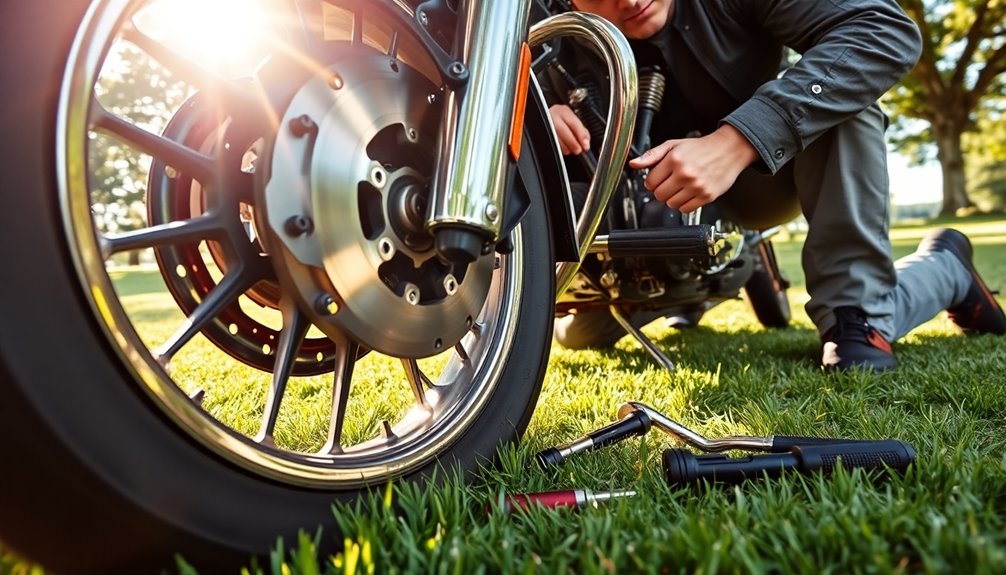
Before you hit the road, a pre-ride inspection is essential for your safety and bike performance. A thorough pre-ride check helps guarantee that all components, including your brakes and tire pressure, are in prime condition.
This proactive bike maintenance can greatly reduce the risk of mechanical failures, which often lead to cycling accidents. By checking for low tire pressure or worn brakes, you can identify potential issues before they compromise your ride.
Regular inspections foster better bike handling and responsiveness, making your cycling experience more enjoyable and secure. Studies show that cyclists who consistently perform pre-ride checks report fewer incidents and increased confidence.
Tire and Wheel Condition
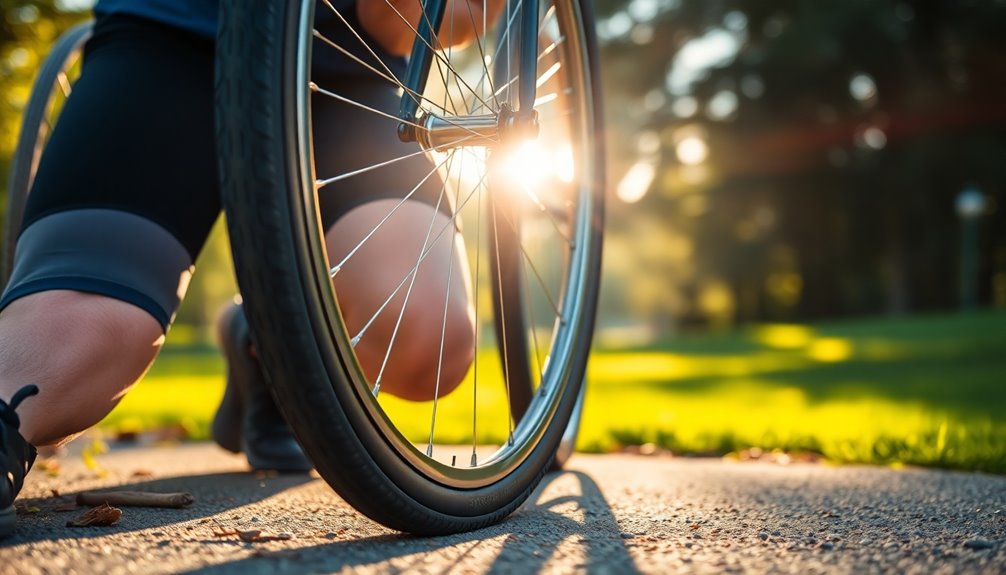
Guaranteeing your tires and wheels are in top shape is essential for a safe ride. Here's what you need to do:
Ensuring your tires and wheels are in excellent condition is crucial for a safe driving experience.
- Inspect Your Tires: Look for cracks, cuts, or excessive wear. Make sure the tread depth meets the legal limit of at least 2/32 of an inch.
- Check Tire Pressure: Verify that the pressure is at the manufacturer's recommended levels. Always check when the tires are cold for the most accurate reading.
- Examine Your Wheels: Spin the wheels to guarantee they're true and free from wobble. Also, check the spokes for bends or breaks and listen for any loose ones.
Brake and Control Functionality

Before hitting the road, squeeze both brake levers to check their engagement; they should respond smoothly without excessive travel.
Don't forget to inspect the control cables for any signs of wear or obstruction, ensuring everything operates freely.
A quick test of your throttle and clutch will confirm that you're ready for a safe ride.
Brake Lever Engagement Check
A thorough brake lever engagement check is essential for safe riding. You want to guarantee that your brake levers respond smoothly without excessive travel.
Here's what to inspect:
- Brake Lever Functionality: Squeeze the front and rear brake levers. They should feel firm upon engagement and stop before reaching the handlebar.
- Brake Pads Clearance: While spinning the wheels, check that the brake pads don't touch the rim or rotor. This helps prevent unnecessary wear.
- Hydraulic Pressure: If your hydraulic brake levers feel mushy, they may need bleeding to restore proper pressure.
Control Cable Inspection
Control cable inspection is essential for maintaining ideal brake and throttle functionality.
First, check the cables for fraying, kinks, or corrosion. Any damage can hinder responsiveness.
Next, inspect the cable ends and lengths to guarantee they're properly lubricated for smooth travel and to prevent sticking.
Pull the brake or clutch lever to check cable tension; there shouldn't be excessive slack, and the lever should engage smoothly without reaching the handlebar.
Also, verify that the cable routing is free from sharp bends or pinch points, which could lead to wear or failure.
Finally, regularly test your brakes and throttle by squeezing the levers and twisting the throttle, ensuring they return to their original position without sticking.
Drivetrain Maintenance
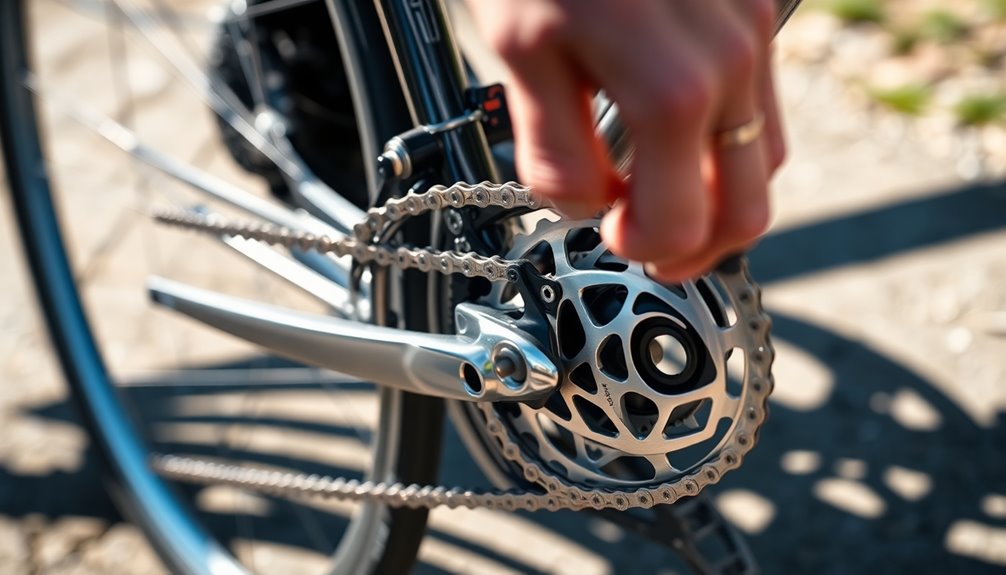
Maintaining your drivetrain is essential for ensuring a smooth and efficient ride. To keep everything running clean and tight, follow these steps:
- Inspect the chain, chainrings, derailleurs, and cassette for dirt and debris. Clean them regularly to maintain peak shifting performance.
- Test shifting by switching between gears. If you notice sluggishness or noise, clean and lubricate the drivetrain as needed.
- Keep an eye on wear; chains, cassettes, and chainrings wear together. Regularly replace the chain to prevent excessive wear on other components.
Don't forget to charge batteries for electric shifting systems before important rides.
Frame and Headset Integrity

Ensuring your bike's frame and headset are in good condition is essential for a safe ride. Start by inspecting the frame for visible cracks or dents, particularly at gussets and accessory mounts, as these can compromise structural integrity.
Look for any paint lifting or bubbling, which may signal deeper issues with the frame material.
Next, check the headset by rocking the bike back and forth while holding the front brake; any excessive play indicates a need for adjustment.
Make sure the headset is free of detents or tight spots during steering, as this affects handling and comfort.
Regularly inspecting both the frame and headset for wear and tear can greatly enhance your bike's overall safety and performance.
Lights and Electrical Systems

Before you hit the road, it's crucial to check your bike's lights and electrical systems. This step guarantees you're visible and safe while riding.
Here's what you need to focus on:
- Test all lights: Make sure your headlights, taillights, brake light, and indicators are fully operational. They should flash correctly and be bright enough for visibility.
- Inspect the battery terminal: Check for secure attachment and cleanliness to prevent any electrical failures during your ride.
- Examine wiring: Look for visible fraying or damage, ensuring all connections are tight and free from pinching or sharp angles.
Fluid Levels and Performance

Checking fluid levels is essential for keeping your bike running smoothly and safely. Before you ride, check the engine oil, gear oil, hydraulic fluid, coolant, and fuel levels to confirm they're at recommended levels for peak performance.
Pay special attention to the hydraulic brake and clutch reservoirs; low fluid levels can drastically impact both braking and clutch operation. Inspect for any leaks around fluid reservoirs and hoses, as these can lead to serious performance issues that need immediate attention.
Don't forget to verify that coolant in the recovery tank is adequate, especially after the engine cools to prevent burns.
Finally, confirm all fluids are clean and free from contamination to avoid mechanical failures and maintain your bike's performance.
Additional Resources for Cyclists
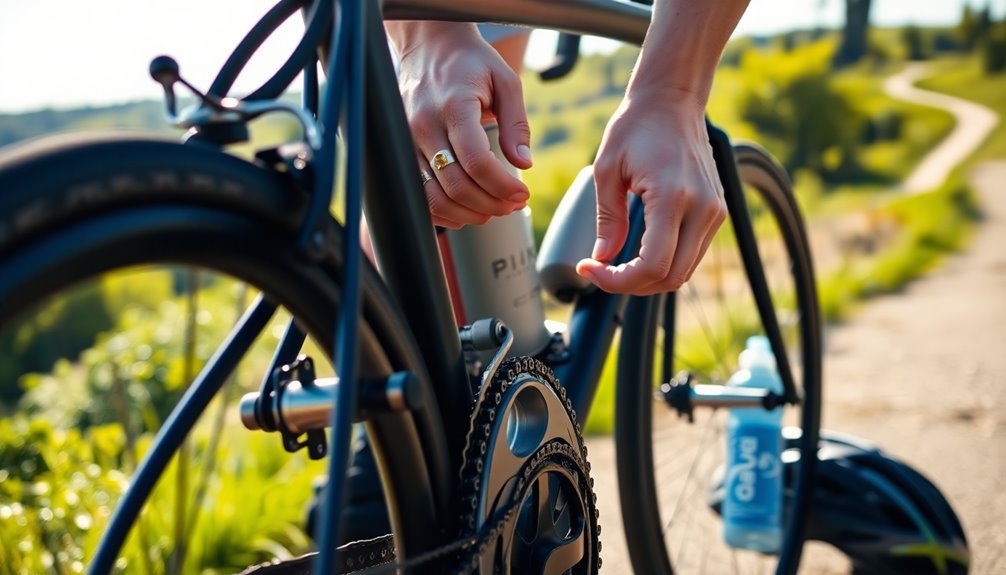
As a cyclist, you can enhance your riding experience by tapping into various resources.
Online maintenance tutorials can guide you through essential bike care, while local bike shops offer valuable expertise and services.
Don't forget to check out safety gear recommendations to keep yourself protected on every ride.
Online Maintenance Tutorials
Many cyclists find that online maintenance tutorials are invaluable resources for enhancing their bike care skills.
You can easily access free video tutorials on platforms like YouTube, where you'll learn to conduct a thorough pre-ride inspection.
Here are three key areas to focus on:
- Tire Pressure: Learn how to check and maintain proper inflation.
- Brakes: Visually inspect your brake pads and check the brake fluid.
- Chain Condition: Understand how to assess wear and lubricate effectively.
Local Bike Shops
While online resources can enhance your bike maintenance skills, local bike shops provide hands-on support that's hard to beat.
These shops offer professional services like tune-ups and flat tire repairs, ensuring your bike's performance is at its peak for a safe ride every ride. You can also attend clinics on basic maintenance and repair techniques, empowering you to check and adjust your bike independently.
Building a relationship with local mechanics means you'll receive personalized advice tailored to your cycling needs. Plus, they stock essential parts and accessories, making maintenance and upgrades convenient.
Many bike shops host community events and group rides, fostering a vibrant cycling culture and connecting you with fellow cyclists.
Safety Gear Recommendations
Building on your bike maintenance skills from local bike shops, it's important to focus on safety gear that protects you during your rides.
Here are three essential items to take into account:
- Helmet: Always wear a properly fitted helmet, as it can reduce the risk of head injuries by up to 85% in an accident.
- Reflective Gear and High-Visibility Clothing: Use reflective gear and bright clothing, as they can make you up to three times more visible to motorists, especially in low-light conditions.
- Padded Cycling Gloves: Invest in padded cycling gloves to enhance grip and reduce hand fatigue, improving your comfort and control on longer rides.
Frequently Asked Questions
Which of These Should You Consult to Learn How to Perform a Pre-Ride Inspection?
To learn how to perform a pre-ride inspection, you should consult the "Pre-Ride Inspection Overview" for its importance.
Next, check the "Pre-Ride Inspection Checklist" for specific items like tire condition and brake functionality.
Don't forget the "Controls and Visibility" section to test your brakes, throttle, and mirrors.
Finally, look at the "Lights and Electrical Systems" to verify all lights work properly, and review the "Fluids and Performance" for fluid levels.
What Checks You Perform in Bike Before Ride Happens?
Before you head out, imagine the thrill of the ride.
You'll want to check your tire pressure and inspect for any cracks or debris.
Test your brakes by squeezing the levers, guaranteeing they engage smoothly.
Give the chain and gears a quick look for cleanliness.
Rock the bike to check for frame integrity, and spin the wheels to confirm they're true.
A little time spent here guarantees a safer, more enjoyable adventure ahead!
What Is a Pre Trip Safety Check?
A pre-trip safety check is essential for ensuring your vehicle's readiness before hitting the road.
You'll inspect tires for proper air pressure and tread depth, checking for any visible damage.
Test the brakes to confirm they're functioning smoothly.
Don't forget to check fluid levels like engine oil and coolant to avoid potential issues.
What Is a Pre-Ride Inspection?
Before you hit the road, think of your bike as your trusted steed, ready for adventure. A pre-ride inspection is your way of ensuring it's in top shape.
You check tire pressure, inspect the brakes, and look over the chain and drivetrain. By doing this, you catch any issues that could lead to trouble down the road.
It's a small effort that keeps your rides safe and enjoyable, so don't skip it!
Conclusion
By taking the time for a pre-ride safety check, you're ensuring your ride is safe, smooth, and enjoyable. You're preventing potential issues, boosting your confidence, and enhancing your overall experience. So, check your tires, inspect your brakes, and tune your drivetrain. Remember, a little preparation goes a long way in keeping you safe on the road. Make it a habit, embrace the routine, and enjoy every ride knowing you've done your part for a secure journey.




